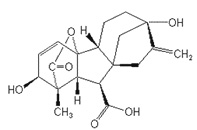|
|
Chemical identity
Technical sheet
Application
Chemical name:Gibberellic acid (GA3)
Use category:Plant growth regulator
Content & formulation:Gibberellic acid 90% TC
Gibberellic acid 40% SP
Gibberellic acid 10% TB
Structure Formula:

Common Name:Gibberellic acid (BSI, draft E-ISO)
CAS No.:77-06-5
CAS Name:(1α , 2β , 4Aα , 4bβ , 10β )-2, 4A, 7-trihydroxy-1-methyl-8-methylenegibb-3-ene-1, 10-carboxylic acid 1, 4A-lactone
Molecular Formula:C19H22O6
Agrochemical Type:Plant growth regulator, biopesticide
Mode of Action:Acts as a plant growth regulator on account of its physiological and morphological effects in extremely low concentrations. Translocated. Generally affects only the plant parts above the soil surface
|
Specification for Gibberellic acid 90%TC
|
|
ITEMS
|
STANDARDS
|
|
Appearance
|
white crystal powder
|
|
Content of a.i.
|
≥90%
|
|
Loss on drying
|
≤1.0%
|
|
Specific Rotation [α]D20
|
≥75%
|
|
Fineness(40 mesh)
|
≥95%
|
|
Specification for Gibberellic acid 40%SP
|
|
ITEMS
|
STANDARDS
|
|
Appearance
|
White to yellow powder
|
|
Content of a.i.
|
≥40%
|
|
pH Value
|
3.0-7.0
|
|
Wetting time
|
≤40s
|
|
Permanence Bubbly (Afterlmin)
|
≤25ml
|
|
Heat Storage Stability
|
Qualified
|
|
Specification for Gibberellic acid 10% TB
|
|
ITEMS
|
STANDARDS
|
|
Appearance
|
White tablet
|
|
Content of a.i.
|
≥10%
|
|
pH Value
|
6~7
|
|
Moisture
|
≤3.0%
|
|
Water insoluble
|
≤1.0%
|
|
Intension
|
≥70N
|
Packing: According to client’s requirement.
Application:Has a variety of applications, e.g. to improve fruit setting of clementines and pears (especially William pears); to loosen and elongate clusters and increase berry size in grapes; to control fruit maturity by delaying development of the yellow colour in lemons; to reduce rind stain and retard rind ageing in navel oranges; to counteract the effects of cherry yellows virus diseases in sour cherries; to produce uniform seedling growth in rice; to promote elongation of winter celery crop; to induce uniform bolting and increase seed production in lettuce for seed; to break dormancy and stimulate sprouting in seed potatoes; to extend the picking season by hastening maturity in artichokes; to increase the yield in forced rhubarb; to increase the malting quality of barley; to produce brighter-coloured, firmer fruit, and to increase the size of sweet cherries; to increase yields and aid harvesting of hops; to reduce internal browning and increase yields of Italian prunes; to increase fruit set and yields of tangelos and tangerines; to improve fruit setting in blueberries; to advance flowering and increase the yield of strawberries; and also a variety of applications on ornamentals. Application rates up to 80 g/a per application, depending on desired effect.
|
|
|
